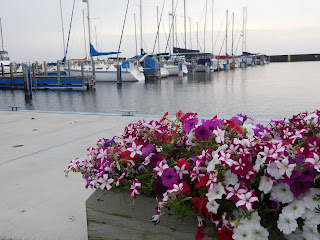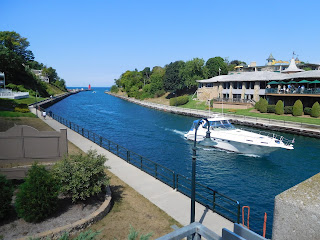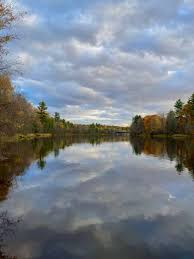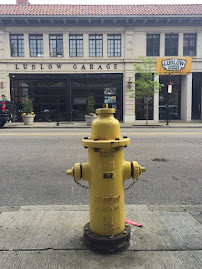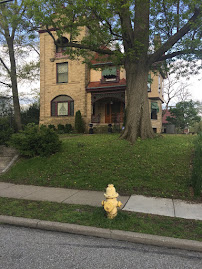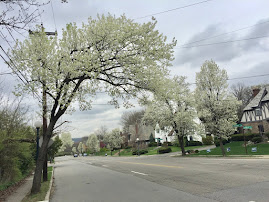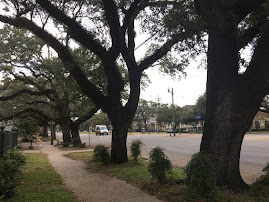The
Menominee River
Dear George,
Northern Wisconsin and the
U.P. were wilderness regions until well into the 1800’s (and, of course, large
chunks still are today). Nonetheless, archeologists have established that
members of the Old Copper Culture lived in the Menominee-Marinette area 10,000
years ago. The first recorded inhabitants of the Menominee River Basin
were the Menominees, known as the “wild rice people.” Early French
explorers described a tribe of 40-80 men living in a small village on the
Menominee River near the present-day Riverside Cemetery. The tribe also
had a summer camp near what’s now Pine Beach along the Green Bay shore in
Marinette. By the early 1820’s the population of the Menominee tribe had
reached about 500, spread across a dozen villages in Wisconsin. As
European-American settlers were drawn to the area by vast lumber and mineral
resources, the Menominee faced encroachment pressures and eventually sold most
of their land between 1821 and 1848 through a series of treaties with the
federal government. (6) (20)
Louis Chappee, the first
settler of European origin on the Menominee River, established a fur trading
post there in 1796. Farnsworth and Brush built the first sawmill on the
river in 1832, and a logging boom had its start by the 1850’s. Charles
MacLeod constructed the first frame building in what was to become the village
of Menominee in 1852. Menominee County’s population in 1860 was less than
500, most of whom were loggers working on the Menominee River. Menominee
County was officially organized in 1863, and the city of Menominee was
chartered in 1883. Thanks to accounts by E. S. Ingalls (1876), the
Western Historical Company (1883), A. L. Sawyer (1911), C. Moore (1915), and
others, we have available a rich history available of the city of Menominee and
the people who played major roles in its development. Drawing from these
and other sources, here are stories of several of the most prominent Menominee
pioneers during the early to mid-1800’s: Louis Chappee, William Farnsworth,
John G. Kittson, Charles McLeod, Andrus Eveland, and John Quimby. (4)
(12) (20) (numbers refer to sources at end)

Louis
Chappee’s gravestone, Menominee County
Louis Chappee
Stanislaus (Louis) Chappee
(also spelled Chappieu or Chaput; pronounced “Shappee”), a French-Canadian fur
trader, was the first settler of European ancestry in the Menominee River
area. Chappee was born in 1766 in the parish of L’Assumption, Quebec,
Canada. He came to Green Bay in 1783, then to Menominee in about 1796
where he established a trading post on the Wisconsin side of the Menominee
River (close to where the Hattie Street bridge now stands). Most
historical accounts indicate that Chappee was an agent of the British American
Fur Company which was operating in the area. At that time thousands of
Indians visited the Menominee River every year because of its abundance of
deer, beaver, otter, mink, muskrat, bear, and other game. Chappee was
described as a bold, powerful man who carried on a successful business with
Native Americans in the area for a number of years. He often had numerous
French-Canadian men who worked for him, and his trading post had the character
of a well garrisoned fort. Historian Alvah L. Sawyer (1911) wrote: “He
seems to have preferred the solitudes and savagery of nature to the
civilization he left behind, and he continued that solitary life, with only the
Indians and his helpers as his companions…” E.S. Ingalls (1876) recounts
an anecdote about Chappee being confronted by a band of Indians who had come
there to rob him. Rolling a keg of gunpowder into the room, Chappee
pointed a loaded pistol into it and threatened to blow everyone up.
Impressed with his courage, the Indians made friends with him and traded with
him for decades thereafter. Along with most Green Bay fur traders, Chapee
fought in the British attack on Fort Mackinac during the War of 1812, then
returned to the fur trade after the war, working for Green Bay fur magnate John
Lawe. Despite his success, Chappee was forced to move five miles upriver
on the Michigan side in 1824 by William Farnsworth and Charles Brush,
competing fur traders who had arrived a year earlier and who wanted the
Menominee River site for a sawmill. Chappee lived at his new trading post
and traded with the Menominees and other tribes until his death on May 6,
1854. Chappee was married to Ke No Ny Ka, a Native American woman, and
they had five children, Jacques, Pauline, Louis, John, and Therese.
Fellow pioneer John Kittson wrote, “He lived a strange life in the bosom of
primeval forests, and saw strange and startling changes in his time.”
There is a historical marker in Menominee County near Chappee’s burial site at
the rapids along County Road 581. The inscription reads: “Louis Chappee,
1766-1856 -- S. Chaput, a noble Frenchman and soldier, explorer, trader
and trapper on the Menominee River. He sleeps here among his red
brothers, on the bank of the beautiful Menominee River.” (4) (6) (11)
(13) (17) (19)

William
Farnsworth (1796-1860)
William Farnsworth
Fur trader William
Farnsworth was born in Vermont in 1796. After establishing a trading post
and founding the city of Sheboygan, he arrived at the Menominee River in
1822. E.S. Ingalls (1876, p. 14) describes Farnsworth and his
Detroit-based partner Charles Brush as “stirring, wide-awake business men, but
without so nice a sense of meum and teum as would stand particularly in the way
of their carrying out any enterprise that they might undertake.”
Farnsworth’s first step was to force Chappee to relinquish his trading
post. Chappee had had a dispute with local Indians in which he lost his
thumb, and he had three Indians imprisoned in Green Bay. Farnsworth
intervened and obtained the Indians’ release, whereupon they granted him five
miles of land along the Menominee River, including the site of Chappee’s
trading post. Farnsworth took over the post on a day when Chappee was
absent and removed all the latter’s possessions. Chappee transported his
goods upriver by canoes and built a new stockade at the foot of the rapids
which came to bear his name, Chappee’s Rapids. Farnsworth and his common
law wife, Queen Marinette, ran the trading post for several years until
Marinette took it over herself. Farnsworth and Brush were the first
entrepreneurs to pack whitefish from the Menominee River in barrels for the
commercial market. Then, responding to the decline of the fur trade, the
two built the Menominee River’s first sawmill in 1832. The water-powered
mill cut 6,000-8,000 feet of timber daily, and its initial yield was used to
build the first frame house on the Marinette side of the river for Queen Marinette.
Farnsworth and Brush operated their mill for several years, but their business
failed and was sold at a Sheriff’s auction for eighteen barrels of white
fish. Farnsworth also owned two Lake Michigan sailing vessels. He
died in a steamer collision on Lake Michigan between Waukegan and Chicago in
1860. (2) (3) (7) (9) (15) (18) (19)

John G. Kittson
John Kittson was the fourth
man of European ancestry to locate on the Menominee River. Kittson was
born in 1812 in Sorel, Quebec, Canada, the son of a British Army officer and
his wife who had been stationed near Montreal. Kittson came to the
Menominee area in 1826 as a "courier du bois" and a representative of
the American Fur Company. He located his trading post on the Menominee
River at the Wausaukee Bend, about thirty miles northwest of Menominee.
The site was at a natural ford which provided a cross for the Indian Trail to
central Wisconsin and which led northward to the ancient copper mines in the
Lake Superior country. Kittson helped members of the Menominee tribe in
their communications with the U.S government which led them to refer
affectionately to him as “The Writer”. Kittson established the first
farms in Menominee County, one at Wausaukee Bend and a second just above
Chappee’s trading post. He taught the Menominees improved methods of
farming. Kittson established an Indian cemetery on his farm, and his
friend, Louis Chappee, was buried there. He built a huge log barn at a
second farm at the Ox-Bow bend of the river, housing horses at one end and cows
at the other. He also built a pelt storage house about a quarter of
a mile down the river, preserving pelts there until they could be taken to the
Green Bay office in the spring. Kittson and his two wives had
approximately eleven children, one of whom was killed in the Civil War in
Sherman’s march to the sea. Kittson himself died in Marinette in
1872 from exposure and suffering resulting from fighting the Peshtigo fire of
1871. In 1881 his wife Margaret and son Robert sold the Ox-Bow
farm. Judge Ingalls said of Kittson: "He was a very
intelligent and stirring man... He had great influence over the Indians, and
was at all times a friend to their interests." (4) (5) (7) (16) (13)
Charles McLeod
Charles McLeod was born in
Ogdensburg, New York, in 1812. A fur trader, hunter, and trapper, he
arrived in Menominee in 1832. He built the first frame house in Menominee
County outside of the current city limits. In 1841 McLeod built the
Menominee River’s second lumber mill on Twin Island. Because iron was
scarce, all the cogs for the machinery were made of wood. Unfortunately,
McLeod’s business was not profitable, and he abandoned it after five
years. McLeod married Elizabeth Jacobs, daughter of Queen Marinette and
her first husband John B. Jacobs. The McLeod’s had three sons, John,
Charles, and Alexander, and three daughters who died in early childhood, Mary,
Elizabeth, and Annie. For the benefit of their own and neighbors’ children,
McLeod built the first schoolhouse on the Menominee River. He was a
member of the first county board of canvassers, and he played a prominent role
in the development of Menominee County. He owned much of the land on the
Menominee side of the river, including extensive real estate on the riverfront
and near the head of Ogden Avenue and what came to be known as Frenchtown.
McLeod died in Menominee in 1893. (2) (7) (1)

Andrus
Eveland (1814-1901)
Andrus Eveland
Andrus Eveland was the
first pioneer to settle on the Green Bay shore in Menominee. Born in
Yarmouth, Ontario, in 1814, Eveland became a Lake Erie sailor at age 17,
travelling between Canada, Buffalo, Cleveland, and other ports. In 1836
he moved to Chicago where he worked as a wheelsman and mate on the steamer
Michigan, a freight and passenger boat that ran between Chicago and St. Joseph,
Michigan. After a stint building harbor piers in Racine, Eveland came
with a crew of men to the Menominee River area in 1841 and built a fish shanty
and cabin a half mile north of the river’s mouth. When he left for the
winter, a sawmill company burnt down his structures. A chief of the
Menominee tribe met him when he returned and handed him a blanket with the
nails from his burnt shanties. Eveland rebuilt in 1842 and became a
permanent resident. For many years he fished in the summer and fall and
made shingles in the winter. He owned much of the land which was to
become the city, and, along with John Quimby, laid out the design for the village
of Menominee. He and his wife, the former Miss Lavina Moore, had nine
children: Charles, Melissa, Henrietta, Mary, Almira, Joseph, Susan Emily, and
Nellie. In 1853 Eveland built the first frame house in the village,
located at 1st St. and 14th Ave. One early biographical statement
recounts how, at age 84, Eveland had set out on his annual 3-mile hike to a
campground at the start of the hunting season, carrying an 80-pound pack on his
back. Eveland died at Menominee on March 2, 1901. (1) (8) (14) (19)

Riverside Cemetery Gravestone, John
E. Quimby (1809-1874)
John E. Quimby
John Quimby settled in what
was then known as the Village in 1845, and he was to become a central figure in
its development. At first Quimby was in charge of the fisheries and ran a
boarding house on the river. He subsequently built a tavern on what
eventually became the site of the Kirby House at the intersection of 1st St.
and 6th Ave. As mentioned earlier, he and Andrus Eveland played
major roles in laying out the village of Menominee. Quimby platted the
original village as "Quimby's Lots", and Eveland platted an
addition. At the time Quimby owned much of the land on which the city of
Menominee now stands, but he never imagined that the settlement would ever
amount to much. For example, in the plans that he laid out Main Street
was only thirty feet wide. His peers at the time recalled Quimby saying
that he did not want to live longer than to see a railroad pass through the
woods. At the time there were not only no railroads, but no wagon roads
or other means of transportation except for boats on the river and the
bay. The surrounding country was unbroken forest which sold for $1.25 per
acre. Menominee County’s first election for county officers was held in
May 1863, and Quimby was elected sheriff and a member of the Board of County
Canvassers. One biographer (1883) described Quimby as “a man of marked
characteristics, and either a warm friend or a good hater.” He was known
as a powerful fighter and a skilled hunter. Quimby died on Jan. 13, 1874,
at the age of 65. His wife, Almira, outlived him by six years and was the
proprietor of the Quimby Hotel. She was known for nursing the sick and
for her kindness to all. Quimby Ave. (now 6th Ave.) and Almyra St.
(now 4th St.) were named after Quimby and his daughter. (7) (10)
(19) (13)
Our family moved from town
to the Menominee River shore exactly 150 years after Louis Chappee first
settled there. It’s hard to imagine what people’s lives were like in
those harsh, challenging times. We owe a debt of gratitude to the men and
women who created the communities from which many tens of thousands of
Menominee and Marinette residents have subsequently benefitted.
Love,
Dave
SOURCES: (1) The Menominee Evening Leader, Oct. 25, 1900,
p. 8 (available from Spies Public Library, Menominee); (2) www.books.google.com, “Deep Woods Frontier, by Theodore J. Karamanski,
Wayne State U. Press, 1989, p. 28; (3) www.books.google.com, Pioneer Society of the State of Michigan, “Pioneer
Collections”, Vol. 1 (1877), p. 265; (4) www.dcl-lib.org, “Menominee Range Memories” by William J. Cummings; (5) www.findagrave.com, “John George ‘The Writer’ Kittson”; (6) www.findagrave.com, “Stanislaus ‘Louis Chappee’ Chaput”; (7) www.genealogytrails.com, ‘Menominee County,’ pp. 473-499 in Western Historical
Company, “History of the Upper Peninsula of Michigan” (1883); (8) www.genealtreemaker.genealogy.com, “Re” Who’s Your Moore”; (9) www.kenanderson.net, “Menominee County”; (10) www.menomineehistoricalsociet6y.org, “Nov. 2010 newsletter”; (11) www.michmarkers.com, “Chapee Rapids”; (12) www.onlinebooks.library.upenn.edu, “Charles Moore, “The History of Michigan.”
Chicago, 1915; (13) www.quod.lib.umich.edu, A. L. Sawyer, “A History of the Northern Peninsula of
Michigan and its People,” 1911; (14) www.rootsweb.ancestry.com,
“Glines/Dean/Warnken/Anderegg/Eveland/Stufflebeam/Related and Very Unrelated
Families”; (15) www.rootsweb.ancestry.com, “Marinette County, Wisconsin: Genealogy and Local
History”; (16) www.rootsweb.ancestry.com, “Norman Wolfred Kittson”; (17) www.rootsweb.ancestry.com, “Oconto County Families and Biographies: Chappue”;
(18) www.teamvanrens.com, "William Farnsworth - married Queen
Marinette"; (19) www.us-data.org, “Centennial History of Menominee County” by E. S.
Ingalls (1876); (20) www.wikipedia.org, “Menominee”
